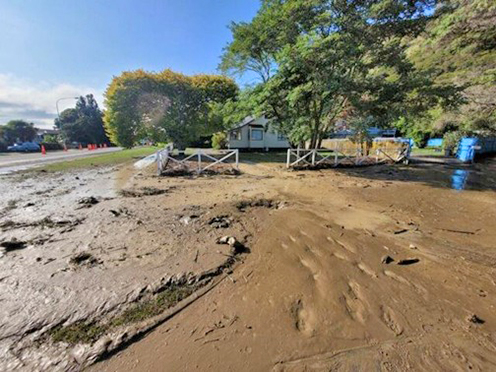Improvements needed for Moore’s Bridge

Diane McCarthy
Whakatāne district councillor Gavin Dennis is seeking improvements to Matatā’s Moores Bridge after a debris flood overflowed the bridge, causing State Highway 2 to be closed in March.
The bridge crosses the Awatarariki Stream on State Highway 2, Arawa Street.
Mr Dennis is also Matatā Volunteer Fire Brigade’s chief fire officer and chairman of the Eastern Bay Road Safety Committee. He made a presentation to the Bay of Plenty Regional Transport Committee last week highlighting concerns about the resilience of the bridge.
He described how the stream, although small, was prone to grow rapidly during localised rain events in the hills behind Matatā. The bridge was not adequate for the high volume of water and debris that flowed down the stream during heavy rain.
The bridge, which predates the Matatā debris flow in 2005, is only 5 metres wide at the creek banks and 2.6m high.
Mr Dennis sought support from the committee to expedite any future plans for increasing the size of the area underneath the bridge.
Also, for the area below the rail bridge upstream of Moore’s Bridge, and the banks around Moore’s bridge to be kept clear of trees and scrub.
He described a localised rain event on March 5 in which 97mm of rain fell in two hours in the hills above Matatā, resulting in about 8000 cubic metres of silt and debris washing down the stream.

“Silt, tree trunks and tree root balls flowed both under and over the top of the bridge, covering State Highway 2, making the road impassable.”
The silt-laden water was waist deep in some places and flowed both under the subway where the highway passes under the railway bridge blocking the road, and back into Pioneer Place and into people’s homes.
The highway was an important route for not only the Eastern Bay of Plenty but also as a key freight route between Gisborne and the Port of Tauranga, he said.
“It’s also an important route for emergency services connecting to Tauranga Hospital.”
These include ambulances transferring maternity patients needing emergency caesarean under lights and sirens since Whakatāne Hospital’s gynecology and obstetrics department was downgraded at the beginning of this year.
As an ambulance officer of 15 years, Mr Dennis said hospital-to-hospital, the route normally took about an hour and 20 minutes.
“I made it one night in 55 minutes, which I was extremely grateful for.”
“If that subway gets blocked, for the ambulance to get to Tauranga, you have to go around the [Rotorua] lakes, which adds another 45 minutes to the trip. For women who have a sudden emergency in the middle of childbirth, that is game-over, really.”
He also referred to the high number of slips and other road closures the Matatā straights are known for and asked for a route security review to be carried out.
New Zealand Transport Agency – Waka Kotahi regional relationships director Andrew Corkill said he was not aware of any funding for any works on the bridge.
He suggested the committee put a recommendation forward toward the 2027 National Land Transport Plan and said he would look further into the maintenance aspects Mr Dennis had raised.
